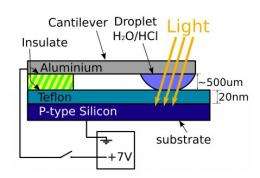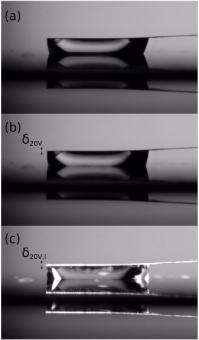January 20, 2012 report
Research team creates photoelectrowetting circuit

(PhysOrg.com) -- Working together, Matthieu Gaudet and Steve Arscott from the University of Lille (IEMN lab) in France have built a circuit using a phenomenon known as photoelectrowetting, which allows a switch to be turned on by shining a light on it. As the two describe in their paper on the pre-print server arXiv, the circuit is made by using the principle of electrowetting to cause a drop of water to thin resulting in a conducting cantilever to fall towards a second conducting material allowing current to pass through.
Electrowetting is a process whereby voltage applied to a liquid causes the wetting angle of the liquid to change. The wetting angle is the amount of rise seen when a liquid sits on a surface and is determined by the adhesive and cohesive forces inherent in the liquid. Differences in wetting angle can be seen when comparing drops of water sitting in a Teflon pan versus on an ordinary countertop. Subsequent research by Arscott showed that the same effect could be achieved by shining a light on a water droplet if it was sitting on an insulated conductor. He called the result photoelectrowetting.

The circuit built by Arscott and his colleague uses photoelectrowetting to allow for switching from a distance using sunlight. Their circuit is essentially a capacitor, where two conducting materials are separated by an insulator. The substrate is made of P-Type silicon; above it is a layer of Teflon, and above that is a space with one drop of water in it. The drop of water holds up the free end of a cantilever made of Aluminum. The circuit is completed when light is shined on the water, causing the wetting angle to decrease, making the drop of water thinner. When that happens, the cantilever falls towards the electrode completing the circuit.
The ability to switch a circuit on from a distance using only light will lead to advances in remote sensors and likely will also aid in the relatively new field of research called Lab on a Chip (LoC), which is focused on constructing self-contained devices that can perform tests on sample materials in remote areas.
More information: "Actuation at a distance" of microelectromechanical systems using photoelectrowetting: proof-of-concept, arXiv:1201.2873v1 [physics.flu-dyn] arxiv.org/abs/1201.2873
Abstract
We demonstrate here a proof-of-concept experiment that microelectromechanical systems (MEMS) can be actuated using photoelectrowetting. In order to demonstrate this, a 30 mu m thick aluminum cantilever is actuated using an ordinary white light source. A deflection of 56 mu m is observed using a light irradiance equal to approx 1000 W m-2 at a bias of 7 V. The deflection of the cantilever relies on the recently observed photoelectrowetting effect [Sci. Rep.1, 184 (2011)]. Such "actuation at a distance" could be useful for optical addressing and control of autonomous wireless sensors, MEMS and microsystems.
© 2011 PhysOrg.com



















